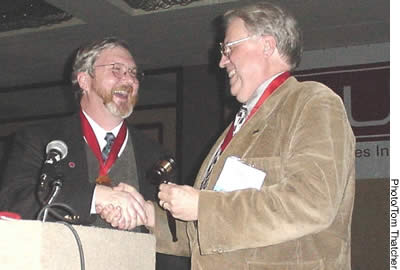 |
 |
 |
|
July 2004
News & Notices
News From:
Commissions
Conference &
Stage Expo
Stage Expo
For the Record
 |
John S. Uthoff, right, receives the Presidential gavel at the Annual Conference & Stage Expo Awards Banquet in Long Beach, California, from Bruce Brockman
|
|
|
John S. Uthoff Becomes USITT President July 1
In preparing for this event, I decided it would be interesting to look at the history of the Institute. I had heard the legends about the “New York Mafia,” the passing of the hat at board meetings to keep the Institute solvent, and the parties and discussions in the Kliegl Suite. I remember Harold Burris-Meyer, Gil Hemsley, Lee Watson, Ned Bowman, Peter Foy, Joel Rubin, and a host of others presenting sessions, talking to people in the halls, and doing their best to help people think about what theatre is all about. According to the history written by Donald H. Swinney, the third President of the Institute, USITT began in the fall of 1959 when Tom DeGaetani (the technical and lighting director for the Juilliard School of Music) and our first President, and Joel Rubin of Kliegl Brothers, our second President, were brought together by David Hays to deal with the problems of a boom in American theatre. They brought together a diverse group including such personalities as Harold Burris-Meyer, Edward C. Cole, John Cornell of Actor’s Equity, Peter Cott of the Society of Stage Directors and Choreographers, Walter Diehl of the IA, Robert Paddock of the United Scenic Artists, Robert Pawley of the American Institute of Architects, Jean Rosenthal – lighting designer and consultant, Henry Wells an Asian scholar and curator of The Theatre Museum at Columbia University, and many other legends of theatre to birth USITT. The first Constitution and By-Laws were written, the officers and Board of Directors were selected,and the organization was established on October 19, 1960. The First Annual Conference followed at Juilliard on February 4 and 5 of 1961. Despite two feet of snow, 150 people attended. From the beginning, USITT was envisioned as a place to share ideas, not only between the founders, but also between theatre artists and artisans worldwide. The international character of the organization was made clear very early. In 1963 the first chapter (now known as Regional Sections) was founded in Toronto, Canada. How fitting that we are traveling to Toronto for our 45th Annual Conference & Stage Expo, and the largest International Conference in our history. With the inaugural exhibit of World Stage Design and hosting the OISTAT World Congress, we once again demonstrate that USITT is firmly behind international communication and collaboration. My own relationship to USITT started in 1974, about 30 years ago. The first Conference I remember is the Anaheim Conference in 1975. I later found out that this was the first conference mounted in a Conference Center and apparently shortly after the Costume Design & Technology Commission was established. My memories, however, are of Architectural Projects, the exhibit floor, free tickets to the banquet, swag, Disneyland, and many great and interesting sessions about things we could never afford in Wyoming, where I was working at the time. This included visits to the various suites to see the latest computerized lighting consoles, acting on whispered invitations made on the Stage Expo floor. I must admit in some ways I was not a very good USITT citizen for my first 20 years of membership. I would go to the Conference when I could, very hit and miss, watch Allen Bailey emcee the first New Product Showcases, see a few programming sessions – usually in architecture since I loved looking at new theatre buildings – and then cut out to see Disneyland, the mountains, aunts, uncles, and cousins. I would return to see Stage Expo and go to the banquet. I had no idea that USITT even had Commissions. That changed, however, in 1991 when Doug Taylor asked me to be the Programming Chair for the 1993 Conference in Wichita. How ironic that someone that had shown so little interest in National Programming suddenly was responsible for making sure it all happened. With that conference, when I finally became a good USITT citizen, I not only found out what a Commission was but why their work was important; I also found out that there was a great group of people all over the world that were all involved in the work of theatre. They show that, although the details were different, they could all work together. Most important of all, I found a home. I have not missed a Conference since. Many of you in this room have been active in the Institute for many more years than I have and know the benefits of participation. Many more have not. I challenge you all to work on the projects, publications, and programming of the Institute. Exhibit your work at Word Stage Design; go to the OISTAT World Congress; propose a program; publish; join a Regional Section; get involved in the projects of the Institute. Most important, don’t let yourself be separated from others that do the work of theatre; talk to everybody. Talk to students, talk to Richard Pilbrow, talk to an international guest, talk to as many of your fellow members as you can. If you do, like me, you will not just find great friends, you may just find yourself. |
||